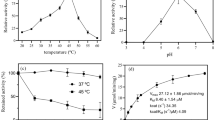Abstract
Ethyl glucuronide (EtG) is a direct alcohol marker, which is widely used for clinical and forensic applications, mainly for abstinence control. However, the instability of EtG in urine against bacterial degradation or the post-collectional synthesis of EtG in contaminated samples may cause false interpretation of EtG results in urine samples. This study evaluates the potential of sodium azide in tubes used for urine collection to hinder degradation of ethyl glucuronide by bacterial metabolism taking place during growth of bacterial colonies. The tubes are part of a commercial oral fluid collection device. The sampling system was tested with different gram-positive and gram-negative bacterial species previously observed in urinary tract infections, such as Escherichia coli, Staphylococcus aureus, Enterecoccus faecalis, Staphylococcus epidermidis, Klebsiella pneumoniae, Enterobacter cloacae, and Pseudomonas aeruginosa. Inhibition of bacterial growth by sodium azide, resulting in lower numbers of colony forming units compared to control samples, was observed for all tested bacterial species. To test the prevention of EtG degradation by the predominant pathogen in urinary tract infection, sterile-filtered urine and deficient medium were spiked with EtG, and inoculated with E. coli prior to incubation for 4 days at 37 °C in tubes with and without sodium azide. Samples were collected every 24 hours, during four consecutive days, whereby the colony forming units (CFU) were counted on Columbia blood agar plates, and EtG was analyzed by LC-MS/MS. As expected, EtG degradation was observed when standard polypropylene tubes were used for the storage of contaminated samples. However, urine specimens collected in sodium azide tubes showed no or very limited bacterial growth and no EtG degradation. As a conclusion, sodium azide is useful to reduce bacterial growth of gram-negative and gram-positive bacteria. It inhibits the degradation of EtG by E. coli and can be used for the stabilization of EtG in urine samples.






Similar content being viewed by others
References
Schröck A, Thierauf A, Wurst FM, Thon N, Weinmann W (2014) Progress in monitoring alcohol consumption and alcohol abuse by phosphatidylethanol. Bioanalysis 6(17):2285–2294
Helander A, Olsson I, Dahl H (2007) Postcollection synthesis of ethyl glucuronide by bacteria in urine may cause false identification of alcohol consumption. Clin Chem 53(10):1855–1857
Baranowski S, Serr A, Thierauf A, Weinmann W, Grosse Perdekamp M, Wurst FM et al (2008) In vitro study of bacterial degradation of ethyl glucuronide and ethyl sulphate. Int J Legal Med 122(5):389–393
Redondo AH, Korber C, Konig S, Langin A, Al-Ahmad A, Weinmann W (2012) Inhibition of bacterial degradation of EtG by collection as dried urine spots (DUS). Anal Bioanal Chem 402(7):2417–2424
Thierauf A, Serr A, Halter CC, Al-Ahmad A, Rana S, Weinmann W (2008) Influence of preservatives on the stability of ethyl glucuronide and ethyl sulphate in urine. Forensic Sci Int 182(1–3):41–45
Leickly E, McDonell MG, Vilardaga R, Angelo FA, Lowe JM, McPherson S et al (2015) High levels of agreement between clinic-based ethyl glucuronide (EtG) immunoassays and laboratory-based mass spectrometry. Am J Drug Alcohol Abuse 41(3):246–250
Packer RA (1943) The use of sodium azide (NaN(3)) and crystal violet in a selective medium for streptococci and erysipelothrix rhusiopathiae. J Bacteriol 46(4):343–349
Lichstein HC, Soule MH (1944) Studies of the effect of sodium azide on microbic growth and respiration: I. The action of sodium azide on microbic growth. J Bacteriol 47(3):221–230
Helander A, Dahl H (2005) Urinary tract infection: a risk factor for false-negative urinary ethyl glucuronide but not ethyl sulfate in the detection of recent alcohol consumption. Clin Chem 51(9):1728–1730
Walton L, Elwell LP (1980) A microbiological assay for sodium azide. Anal Biochem 101(1):39–43
Ciesla Z, Mardarowicz K, Klopotowski T (1974) Inhibition of DNA synthesis and cell division in salmonella typhimurium by azide. Mol Gen Genet 135(4):339–348
Mc Farland J (1907) The nephelometer:an instrument for estimating the number of bacteria in suspensions used for calculating the opsonic index and for vaccines. J Am Med Assoc XLIX(14):1176–1178
Al-Ahmad A, Wiedmann-Al-Ahmad M, Auschill TM, Follo M, Braun G, Hellwig E et al (2008) Effects of commonly used food preservatives on biofilm formation of Streptococcus mutans in vitro. Arch Oral Biol 53(8):765–772
Hernández Redondo A, Schroeck A, Kneubuehl B, Weinmann W (2013) Determination of ethyl glucuronide and ethyl sulfate from dried blood spots. Int J Legal Med 127(4):769–775
Dresen S, Weinmann W, Wurst FM (2004) Forensic confirmatory analysis of ethyl sulfate—a new marker for alcohol consumption—by liquid-chromatography/electrospray ionization/tandem mass spectrometry. J Am Soc Mass Spectrom 15(11):1644–1648
Halter CC, Dresen S, Auwaerter V, Wurst FM, Weinmann W (2008) Kinetics in serum and urinary excretion of ethyl sulfate and ethyl glucuronide after medium dose ethanol intake. Int J Legal Med 122(2):123–128
FDA UDoHaHS (2001) Guidance for industry: bioanalytical method validation
Schnappinger D, Hillen W (1996) Tetracyclines: antibiotic action, uptake, and resistance mechanisms. Arch Microbiol 165(6):359–369
Acknowledgements
We would like to thank the Group for Oral Microbiology in Freiburg, Germany and the Team of Forensic Toxicology and Chemistry at the Institute of Forensic Medicine Bern, Switzerland. Furthermore, we would like to extend our gratitude to Michaela Brcak from Greiner Bio-One for providing the saliva transfer tubes from the saliva collection system.
Author information
Authors and Affiliations
Corresponding author
Ethics declarations
Informend consent was given for obtaining the blank urine sample. All procedures performed were in accordance with the ethical standards of the institutional and national research committee and with the 1964 Helsinki declaration and its later amendments or comparable ethical standards.
Conflict of interest
The authors declare that they have no conflict of interest.
Rights and permissions
About this article
Cite this article
Luginbühl, M., Weinmann, W. & Al-Ahmad, A. Introduction of sample tubes with sodium azide as a preservative for ethyl glucuronide in urine. Int J Legal Med 131, 1283–1289 (2017). https://doi.org/10.1007/s00414-017-1633-3
Received:
Accepted:
Published:
Issue Date:
DOI: https://doi.org/10.1007/s00414-017-1633-3




